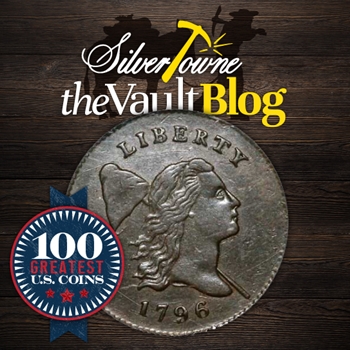
In case we do not say it enough, let us just remind you and ourselves that United States coinage has a very rich history. From the lowest of denominations to the highest, coins represent a special category within numismatics, and the older they are, the better in most cases. When it comes to the very earliest of official United States Mint early coinage, that fact rings even more true.
In our continuing series exploring the top 100 Greatest United States Coins, we take a look at one of the earliest and lowest denomination coins to come from the United States Mint. With author Jeff Garrett and help from Ron Guth, Whitman Publishing’s fourth edition places this specific year dated coin on the list with two varieties attached to it. Let us explore further into this early dated coin.
#70 - 1796 Liberty Cap Half Cents, With Pole and No Pole
Of the half-cent denomination, the 1796 is the rarest in terms of mintage for the series. How is that? In 1795, the United States produced 139,690 coins. In 1797, nearly 129,000 pieces were minted. Right in between there in 1796, the Mint produced just 1,390 coins of the half-cent denomination. Why? The availability of copper and resources at the Mint had everything to do with this rarity.
Early years at the Mint were found to be difficult as finding enough copper to produce both the half-cents and the large copper cents was challenging. Domestic sources of the precious metal were unrealized as the process of smelting in the United States did not exist yet. These two factors caused the Mint to come up with different ways to procure the copper metal. In early 1795, they proceeded the purchase of over a 1,000 pounds of cent-sized copper tokens already stamped with advertising from merchants of New York City. They were cut down and used to produce the 1795-dated half-cent coins. They also found a way to use misstruck or defective large cent coins that were also cut down and turned into half-cent dies. Because of these creative uses, half-cents from 1795-1797 often show parts of the designs of the original advertising tokens.
As the tokens were used for 1795, there was nothing left for 1796. All the copper had been used except for spoiled cents. Thankfully, a small quantity of sheet copper that was locally sourced helped to strike some of the 1796 half-cents. While the Mint had its issues with copper sourcing, it focused more on the higher end coins it was introducing to the public. Those coins were the dime, quarter dollar, and $2.5 gold quarter eagle. They also focused on the basis for which the United States relied on monetarily which was the large cent and the silver dollar. Because attention and focus were paid elsewhere, the 1796 half-cent was not a priority.
After nearly 1,400 coins were produced, two varieties came from 1796. The normal version (With Pole) and what Garrett refers to as the “unfinished version” (No Pole). The No Pole variety lacks the staff that supports the liberty cap on the obverse of the coin. This variety also happens to feature a heavy crack through the front of the coin. Regardless of variety, they are both rare, but the No Pole is more so.
Historical values indicate that in 1960, the With Pole variety in a Very Fine condition was $750 while the No Pole variety in the same condition valued at $1,250. Cut to the fourth edition of this publication and the same With Pole variety in a Very Fine condition values at $85,000. The No Pole variety is much higher at $200,000.







